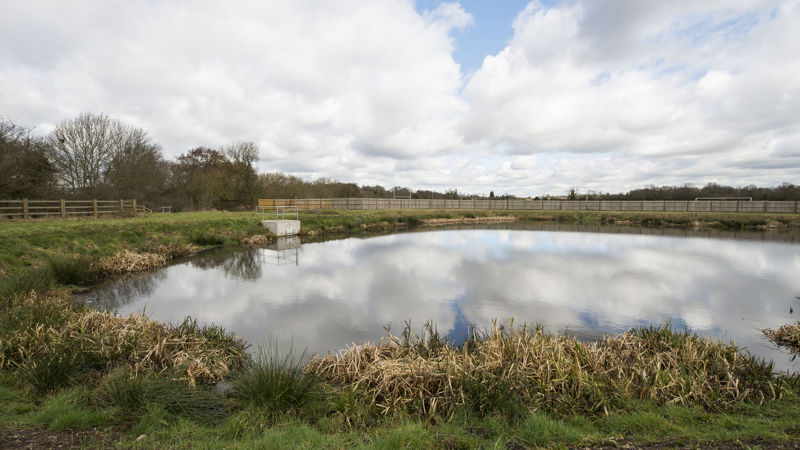Water quality
Making sure water run-off from roads doesn't pollute the environment is our legal duty. It's also the right thing to do.

What is water quality and why does it matter?
Water quality is important for everyone in England:
- high quality water is free from harmful chemicals and keeps us safe
- good water quality helps protect aquatic life, which is important for biodiversity and ecosystems
- farmers need clean water for crops and livestock
- many businesses need high-quality water for their production processes
- clean rivers and lakes help attract visitors, boosting local economies.
Why is this important to us?
We operate England’s motorways and major A roads.
This is only around 3% of England's roads, but our network carries:
- one third of all traffic
- two thirds of all freight
We know that water run-off from our network can affect water quality in the surrounding environment.
We have a responsibility to manage that water so it does not cause pollution.
Road run-off explained – and how we manage it
Managing water quality means understanding:
- what's in the water that runs off the road surface
- the characteristics of the environment around it
- measures we can use to help remove pollutants from the water before it's discharged.
Here are some examples of each.
Highway contaminants
Road run-off affects the quality of water around our network. Vehicles using, building or maintaining roads produce a range of potentially toxic contaminants when:
- fuel is combusted
- vehicles corrode
- tyres, roads and brakes wear down
- atmospheric deposition occurs, where particles from the atmosphere collect on the surface of the road
Contaminants include:
Sediments
Sediments can smother riverbeds and transport pollutants to nearby bodies of water.
A number of contaminants can stick to sediment and be washed away.
Hydrocarbons
Hydrocarbons in run-off are often from:
- lubricating oils
- fuel
- hydraulic fluid
- tyre wear
- exhaust emissions
- places where the road has worn down.
Microplastics
Small pieces of plastic under 5mm that are insoluble in water and don’t break down quickly. Microplastics often come from tyre wear, or where road markings have worn down.
Where does run-off go?
Run-off can flow into:
Surface waters
Rivers, canals, lakes, ponds, reservoirs, estuaries and tidal waters. We have all of these types of surface water around our network.
Groundwater
Water found underground in cracks and spaces in soil, sand and rock. It is stored and moves slowly through geologic formations of soil, sand and rocks called aquifers.
Ways we can stop pollutants getting into the environment
Wetlands
A nature-based solution to water quality. Wetlands are man-made ponds with shallow areas where bottom-rooted plants can grow. These plants can filter pollution from the water.
Filter drains
Perforated drain-pipes buried 4 inches below ground in trenches filled with washed gravel. Filter drains designed to drain run-off away beneath the road.
Vortex Separators
Tanks buried below ground that trap sediment, oil and debris carried by water.
What action are we taking?
In our Environmental Sustainability Strategy, we commit to improving the water environment around our network. We'll do this by taking specific actions to mitigate water pollution from our outfalls.
Our 2030 Water Quality Plan sets out how are going to do this.
The plan identified 1,236 outfalls and soakaways that might be at high risk of polluting the environment around them.
We're on course to deliver our commitments from this plan.
In February 2025, we completed our validation and verification work on the 1,236 locations.
In total, we expect that around 250 locations need mitigation work, which we're now developing solutions for.
This includes some locations in addition to the 1,236 sites where, through our data improvement work, we've identified further locations where highway runoff could be impacting water quality in nationally designated habitats.
We've also worked with a wide range of external stakeholders to make sure we meet our 2030 Water Quality Plan objectives.
We regularly meet our suppliers, government departments, environmental groups and campaigners, to share our progress and seek input on our work.
In September 2025, we shared two technical documents with suppliers and stakeholders to help set out the approach we're taking and invite feedback:
- The design playbook, a summary of the assessment methods we're using to help decide the best solution for each location, and
- A design palette, with details of proposed solutions.
We're increasing our understanding of water outfalls and their effects on the environment. We'll continue to look beyond these locations and take action where it's needed.
An evolving challenge
Since 2010 all new roads have been built to mitigate the risk of pollution to water courses.
However, our network has been built over decades to differing design practices.
We're investing to make sure it supports current environmental and drainage standards.
We and our contractors also need to maintain existing drains so they keep working properly.
What’s next?
We have a lot of work to do to improve water quality around our network in the next 5 years.
We need to move quickly to solve the potential risks of road run-off to the environment, human health and the economy.
We're committed to managing the quality of water around our network to the highest standards possible with the resources we have.
This means we must speed up our programme and standardise the approach to design across our teams.
Our design and delivery options should be sustainable, innovative and follow regulations.
We aim to:
- use nature-based solutions first
- remove hazards and handle any remaining risks
- keep costs in mind
- offer sustainable ways to reduce pollution risks
- reduce disruption to our network
- improve what is already in place
- consider future maintenance, operation and demolition needs
We've created a standard list of options for our teams to use when designing water quality solutions.
Using this resource together with data we've gathered about outfalls and soakaways, our teams can decide on the best design option.
